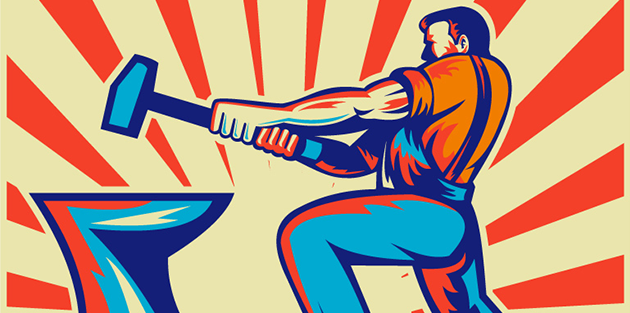CLICHÉS OF PROGRESSIVISM #31 – “Labor Unions Raise Wages and the Standard of Living” by Hans F. Sennholz
To believe that labor unions actually improve the lot of working people is to suggest that the capitalist economy fails to provide fair wages and decent working conditions. It is to imply that a free economy does not work satisfactorily unless it is “fortified” by union activity and government intervention.
The truth is that the unhampered market society allocates to every member the undiminished fruits of his labor. It does so in all ages and societies where individual freedom and private property are safeguarded. (The process works faster and more efficiently in our high-tech, information age with a labor force more mobile than ever before but it worked in previous times too, so long as individuals were free to accept or reject the offers of employers, or to leave one employer and work either for another or for himself–Editor.)
The reason your great-grandfather earned $5 a week for 60 hours of labor must be sought in his low productivity, not in the absence of labor unions. The $5 he earned constituted full and fair payment for his productive efforts—a voluntary contract he likely entered into because it represented his best opportunity. The economic principles of the free market, the competition among employers, a man’s mobility and freedom of choice, assured him full wages under the given production conditions.
Wages were low and working conditions primitive because labor productivity was low, machines and tools were relatively primitive, technology and production methods were crude when compared with today’s. If, for any reason, our productivity were to sink back to that of our forebears, our wages, too, would decline to their levels and our work week would lengthen again no matter what the activities of labor unions or the decrees of government.
In a free market economy, labor productivity determines wage rates. As it is the undeniable policy of labor unions to reduce this productivity (as measured per man-hour) by forcing compensation up or spreading out the work with restrictive work rules, they have in fact reduced the wages of the masses of people although some privileged members have benefited temporarily at the expense of others. This is true especially today when the unions enjoy many legal immunities and considerable political powers. And it also was true during the nineteenth century when our ancestors labored from dawn to dusk for low wages.
Through a variety of coercive measures, labor unions merely impose higher labor costs on employers. The higher costs reduce the returns on capital and curtail production, which curbs the opportunities for employment. This is why our centers of unionism are also our centers of highest unemployment; they are also the industries that have seen the most dramatic declines in numbers of existing jobs, because like anything else, the higher the price, the less will be purchased. (It’s also why compulsory unionism states for years have shown lower rates of both employment growth and wage rates than so-called “right-to-work” states. See http://www.mackinac.org/4290 – Editor.)
True enough, the senior union members who happen to keep their jobs do enjoy higher wages. But those who can no longer find jobs in unionized industries then seek employment in nonunionized activity. This influx and absorption of excess labor tends to reduce their wages. The resulting difference between union and nonunion wages rates gives rise to the notion that labor unions must indeed benefit workers. In reality, the presence of the nonunionized sectors of the labor market hides the disastrous consequences of union policy by preventing mass unemployment. (Nonetheless, with 94% of today’s private sector workers being completely non-union, and many of them enjoying very high wage rates, it’s increasingly difficult for unions to argue that workers without unions are exploited and unprotected. – Editor.)
Summary
- Wages can only be paid out of what is produced (no production, no wages), therefore greater productivity is the key to higher wages.
- Unions typically hamper production. Union activity may result in some people getting more but without an increase in productivity, that simply means that some other people must get less. Either you bake a bigger pie for everybody or you just slice the pie up differently.
- It looks sometimes like unions have actually forced wages higher because of the lower wages in non-unionized businesses. But the latter are caused in part by the outflow of labor from unionized sectors to non-unionized ones. Unionized auto-workers today, for example, may make a little more per hour than their nonunionized counterparts but there are a lot fewer of them too!
For further information, see:
“Why Wages Rise—Part I” by F. A. Harper
“Why Wages Rise—Part II” by F. A. Harper
“Can Labor Unions Really Raise Wages?” by Henry Hazlitt
ABOUT HANS F. SENNHOLZ
Editor’s Note: This essay, with minor updates, was first published in the 1962 book, “Cliches of Socialism.” Prior to serving as president of the Foundation for Economic Education from 1992 to 1997, the late Hans F. Sennholz was chairman of the department of economics at Grove City College in Pennsylvania from 1956 to 1992. A noted economist and teacher of the “Austrian” school, he earned his PhD under the tutelage of Ludwig von Mises. Read more about him here. The featured image is courtesy of FEE and Shutterstock.


